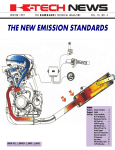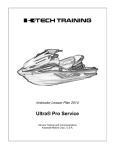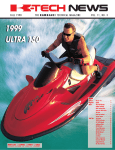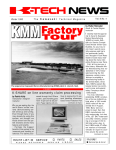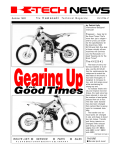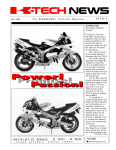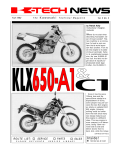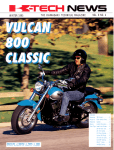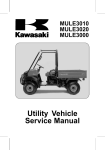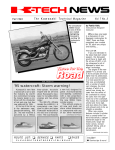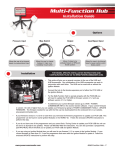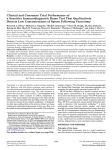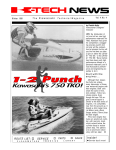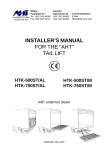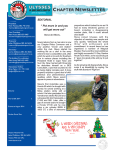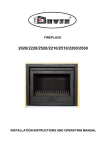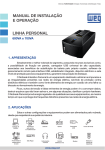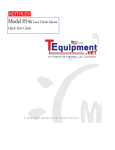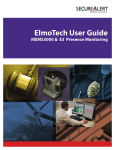Download K-Tech News Vol.11 No.1
Transcript
SPRING 1998 THE K AWA S A K I TECHNICAL MAGAZINE VOL. 11, NO. 1 Kawasaki Comes to Bates: Technical College is One of Six Sites in Nation for Cycle Maker’s Dealers to Train Technicians by Gestin Suttle The News Tribune—Tacoma, Wash. Bates Technical College has revved up its motorcycle repair program and is now one of six sites in the nation offering dealer technician training for Kawasaki Motors Corp. Kawasaki dealers from around the Northwest will send their technicians to the school once a year during a four- to sixweek span in February and March. This year’s program drew about 100 participants, Kawasaki instructor John Griffin said. Cont’d on page 2 ROUTE LIST ❑ SERVICE ❑ PARTS ❑ SALES P L E A S E R E T U R N T O S E R V I C E L I B R A R Y INSIDE Features Regional News Tech Tips Bates Training School . . . 2 Update . . . . . . . . . . . . . 3 Voice of the Customer . . . 5 Removing Decals . . . . . . 5 Closed Course Comp.. . . . 6 Coolant Pressure. . . . . . . 6 VN1500 Transmissions . . 7 Swim Step Pad . . . . . . . . 8 JS750-B/C Hoods. . . . . . 8 Mule Wheel Bearings . . . 9 KX125-K Cylinder. . . . . . 9 Vulcan Timing. . . . . . . . 10 CVT Drive Systems . . . . 11 Hotline Worksheet . . . . 11 Finding Manuals. . . . . . 12 Cover Story Rapids, Bates Technical College- cont’d Technical Training For Northwest Dealers by John Griffin Instructional Designer/Instructor In this issue, we are featuring an article that ran in The The training enhances program the Mich.; and Piscataway, N.J. trainer for the dealers’ technicians, but the Kawasaki Tacoma “The (South Tacoma) com- workers must pay their own school’s existing 20-month munity itself is perfect for food, transportation and lodg- program in marine, motorcy- what we’re looking for” in the ing, Griffin said. cle and outdoor power equip- Northwest, Church added. ment repair at its South The parallels part in the workshops gener- Campus on South 78th Interstate 5 and is near ally have training in motorcy- Street. motels and restaurants, he cle repair, but need to learn said. specifically how to repair Kawasaki officials learned campus The technicians taking News Tribune, March 14, 1998. of Bates last year while in the In exchange for providing It was a fitting end to area for a seminar. They a place for Kawasaki to set up It’s important for the tech- tuned in to the school’s radio a training site in the school’s nicians to keep their skills up Bates Technical College in station, KBTC 91.75 FM, and 10,000-square-foot motorcy- to date because the technolo- Tacoma, Wash. Many classes heard an ad for Bates’ equip- cle shop, the Japan-based gy is always changing, Griffin were full to capacity as dealers ment repair program, said company explained. took advantage of this training Don Kawasaki’s $139,000 worth of equip- This year’s program is con- manager of service training ment, including six motorcy- sidered a success, Church and communications depart- cles, four new watercraft, an said. ment. all-terrain vehicle and a small Kawasaki’s successful first season of technical training at opportunity. Nine different classes were offered, including training on Police motorcycles, Jet Ski Watercraft, Mules, ATVs, and motorcycles. The Bates facility in Tacoma is a permanent training facility for Kawasaki, so Northwest dealers should plan on sending technicians yearly. Dealers can also benefit from a new resource of entry level technicians with Kawasaki experience, trained year-round at He Church, met with Chris has donated all-purpose utility vehicle. lege’s South Campus, and site year-round and will be On Friday, Brent Eiffert of immediately things started upgraded as new equipment Cont’d on page 12 rolling, Church said. comes along, said John Irish, “They were just very open to working with us,” he said. ing education and apprentice- The motorcycle company ship at the college. Northwest for dealer training to work on the Kawasakis and equipment stay at Bates because the nearest training and will be able to pass their and are utilized in Bates’ site, at Kawasaki’s U.S. head- knowledge along to Bates’ reg- Marine, Motorcycle, and Power quarters in Irvine, Calif., was ular students, Irish said. difficult for local dealers to Currently, 36 students are reach, Church said. The oth- enrolled in the Bates equip- er Kawasaki training sites are ment repair program, he said. in Dallas; Atlanta; Grand Kawasaki provides its own Bates program or graduates, call Instructor John Irish at (253) 596-1729.◆ SPRING 1998 full classes,” he said. associate director of continu- training aids, manuals, tools, To get more information on the been up here and we’ve had The equipment will stay on Bates instructors will learn Equipment Mechanic program. “It’s the first year we’ve Manning, director of the col- was looking for a place in the Bates. The Kawasaki products, Kawasakis, Griffin said. 2 K-TECH NEWS Cover photo: Sean Phillips, left, and Brent Eiffert, technicians at Kawasaki Bellevue, work at Bates Technical College on a motorcycle engine as part of a three-day repair class. Regional you may want to add a fourth. Here are some good sizes from what I’ve seen in current tool catalogs: K-TECH News Vol. 11, No. 1 Spring 1998 K-TECH News Staff Publisher * 3/8 or 1/4 inch drive with a range of 30 - 200 in. lb * 3/8 inch drive with a range of 20 - 100 ft-lb (2.2 - 14 kg-m) * 1/2 inch drive with a range of 40 - 250 ft-lb (5 - 34 kg-m) Kawasaki Tech Services Publications Manager Don Church Executive Editor PISCATAWAY/ GRAND RAPIDS Enough Torque Gary Herzog Editor-in-Chief Gregg Thompson Communications Editor John Griffin Regional Editors Piscataway/Grand Rapids Fred DeHart Atlanta/Dallas Walter Rainwater Irvine/Tacoma Robert Taylor Contributors Dave Behlings, Ginny Maatman, Keith Pestotnik, Ray St. John, Charles Yim Graphics/Production Graphic Art Gregg Thompson Photography Dave Corey Production Holland Marketing Services ©1998 Kawasaki Motors Corp., U.S.A. All rights reserved. Published by Kawasaki All suggestions become the property of KMC. Sending a service suggestion gives Kawasaki permission to publish and/or use it without further consideration. Specifications subject to change without notice. Has this ever happened to you? You are going to torque the cam cover bolts and the spec is 1.0 kg-m or 87 in. lb. You set your 0100 ft-lb torque wrench to the equivalent 7.2 ft-lb and before your wrench decides to click, you realize you are about to strip the threads in the head or snap the bolt! Time out! Now is the time to put that torque wrench aside and get out a smaller one. The first 20% of full scale on click-type torque wrenches is notoriously inaccurate. Some manufacturers only guarantee their wrench accuracy at 20% of full scale and up. Get out a smaller wrench, that allows you to use the top 80% of the scale. With the smaller wrench you will probably find those cam cap bolts torque to spec with no problem. A good service department should have at least three sizes of torque wrenches on hand and SPRING 1998 The two smaller torque wrenches should probably be click-style wrenches for convenience. The amount they get used will justify the expense. The largest one could be the less expensive beam type since it won’t be used so often. With click-style torque wrenches, remember to do the following: * Use in the upper 80% of the scale for best accuracy. * Turn the handle clockwise to adjust the torque setting. Turning the handle counterclockwise to set it will be less accurate. * Always bring the torque wrench back to its lowest setting when not in use. Storing your wrench at high torque settings will cause it to lose accuracy. * Take care of this expen- 3 K-TECH NEWS sive and indispensable tool. Keep it clean and don’t drop it.◆ Fred DeHart 201 Circle Drive N. #107 Piscataway, NJ 08854 (908) 469-1221 ATLANTA/DALLAS Reflections of a “Rookie Season” Millennium Kawasaki in Lilburn, Ga., has made a good start in its first 18 months, and its owners have found the learning curve steep but rewarding. Co-owner Ken Shiver shares some insights about the shop’s rookie season. Sales: We were pleased to make Ichiban in our first year. We think sales ultimately boils down to a relationship. If the customer feels good about the product, the salesperson and the shop, they will usually buy. Our focus is on friendly, knowledgeable staff and a low-pressure environment. Our Cont’d on page 4 Regional Regional News -cont’d goal is long-term customers and repeat business. Service: We have found that a shop’s reputation is made through the service department. It is important to do each job properly, on time, and at a fair price—the result has been numerous referrals. We also try to introduce every new customer to the service manager. This gives them confidence from the beginning. We even ask the technician to speak with customers occasionally. This may cost a little in short term productivity, but it is time invested in future business. Advertising: We will advertise in fewer media, but more consistently. We also participate in the Falls Agency programs— they’ve provided a good response. Demo Ride: Liability concerns make demo rides rare for us. We have found that what customers really want when they ask to ride the unit is confidence. We suggest that they buy the unit, and if it isn’t all they expected, return it (within 25 miles or less) and we’ll take it back. Seeing the confidence we have in the product usually gives them confidence, too. Promotions: Being involved is a big key. Two of our employees are racers, so they bring in a lot of motocross and trail riders. We had our first “Fun Ride” on a cold day in February, and were pleased to have a big turnout despite the weather. People want a shop they can interact with, and we want to become as good at that as we can.◆ 57001-1407 (VN1500-E1/G1) Drive Shaft Holder 57001-1408 (ZX-6R) 57001-1400 (ZX-9R, VN1500-E1, G1) Throttle Sensor Setting Adapter adapter (P/N 57001-1408), different from the ZX-9R. And the VN1500-E1/G1 uses a new drive-shaft holder (P/N 57001-1407) and flywheel holder (P/N 57001-1410). The VN1500E1, G1 use the same throttle sensor adapter as the ZX900C1. More good news on the tool front is the availability of the updated Special Tool Catalog containing special tools up to 1998. Not only does the catalog contain Kawasaki special tools but also tools that can help a technician perform a job more efficiently. These tools include micrometers, T-gauges, small hole gauges, calipers, mercury vacuum Walter Rainwater 6110 Boat Rock Blvd. S.W. Atlanta, GA 30378 (404) 349-2000 IRVINE/TACOMA New Model Special Tools and Special Tool Catalog The all-new ZX900-C1, ZX600-G1 and VN1500E1/G1 models require some new special tools. The ZX-9R uses a new flywheel puller (P/N 570011405), fork cylinder holder (P/N 57001-1406), and throttle sensor setting adapter (P/N 57001-1400). The ZX-6R requires a new throttle sensor setting SPRING 1998 gauge, two-stroke pressure tester, timing lights, and much more. The new catalog part number is 99960-0065-03. What makes this even better is that the new catalog will be sent to your dealership automatically at no charge. We will be stocking copies just in case you need more (at a nominal charge). ◆ Rob Taylor 9950 Jeronimo Road Irvine, CA 92618 (714) 770-0400 57001-1406 (ZX-9R) Fork Cylinder Holder 57001-1405 (ZX-9R) Flywheel Puller 57001-1410 (VN1500-E1/G1) Flywheel Holder 4 K-TECH NEWS News Voice of the Customer Discovering Issues that Impact Customer Satisfaction by Don Church Manager, Service Training and Communications Last year Kawasaki’s Technical Services Division contracted with BI Research Systems to help us conduct a program for measuring and monitoring motorcycle customer satisfaction. The areas we were looking at specifically were customer feelings about the condition of the product itself and the after-sale service provided by the Dealer and Kawasaki. The results of interviews with 500 owners and 21 dealers were analyzed to determine which specific issues have the most impact on overall customer satisfaction. Here is the good news! Kawasaki’s Technical Services recorded an overall delivery is considered a defi- cies. Customers also indicat- nite strength! Customers ed that they want more also rate service quality instructions at the time of from their dealer (7.7) quite new vehicle delivery such as highly. required maintenance and recommended service inter- During a “Voice of the vals. Customer” workshop after What this means is this! the results of the survey were compiled, members of Even when you are very Tech Services identified the busy, MAKE THE TIME to strongest factors affecting explain in detail the warran- customer satisfaction and ty policy as you give the cer- established priorities for tificate to the customer. Go KMC and Kawasaki dealer through the Owner’s performance improvement. Manual and explain to your As this article goes to press, customer the maintenance we are developing associated requirements. Explain the action plans. controls, and adjust them to suit the customer. You will be hearing more from us on improvements we will be making and recommendations for steps dealers can take to enhance customer satisfaction. Don’t forget, your customer just spent their hard earned cash. And the customers we surveyed said that all they wanted was a little of your time. It will CSI score of 81, indicating solid performance in the customer satisfaction arena. make a difference in their Here are the opportunities. satisfaction. We all know We can share with you that satisfaction with the Overall satisfaction with right away some important product and dealer service motorcycle product quality findings. There seems to be a are what build customer loy- is very high (8.6 on the 10- gap between customer alty. point scale). Furthermore, expectations and the actual product condition at time of terms of the warranty poli- SPRING 1998 Vinyl Eraser for Removing Decals Good selling (and servicing) this season!◆ 5 K-TECH NEWS As most of you know, removing decals can be a messy and time-consuming chore. This is especially true of Jet Ski watercraft; the larger the decal the bigger the mess. Just peeling the decal off takes plenty of time, but then it usually leaves a huge sheet of adhesive behind, which is even harder to remove. There is a special tool called the "Vinyl Eraser" offered by The Eastwood Company of Frazer Pennsylvania. This tool is designed to remove all kinds of vinyl graphics from painted surfaces. It does a nice job of removing a decal fairly quickly while leaving the paint undamaged (not recommended for lacquer finishes). The eraser should be mounted in a highspeed drill or an air tool and spun at 3,500 to 4,000 rpm. The tool becomes less effective below 3,500 rpm and should not be used at speeds above 4,000. The Eastwood Company also sells an aerosol solvent called Pre, which does a good job of cleaning up after removing the decal. Both products can be ordered by calling Eastwood's toll-free number (800) 345-1178.◆—Ed. Tech Tips California Closed Course Competition Units by John Griffin Instructional Designer/Instructor In 1998, new emission standards affect California’s Off Highway Vehicle program. Off-road motorcycles and ATVs meeting the standards are eligible for a “green sticker” license and models that don’t are classified as "closed course competition units." Currently all two strokes and some manufacturer’s four strokes fall into this category. Vehicles without green stickers can only be used on private land and closed courses such as race tracks, or designated off-road events. Here are six common questions about this pro- gram. 1. Why are some customers still receiving green stickers with ’98 KX models? The DMV made a "procedure" change, not a computer change, meaning the system relies on DMV employees to manually check which Vehicle Identification Numbers (VIN) are ineligible. Whenever people are involved, errors occur. In 1998, even riders from out of state need a license on California’s public land. This one year permit sells for $20. ownership be issued? A title or "pink slip" is available for a one-time $10.00 fee. This is important for customers who are financing their purchases. 2. Will people receiving green stickers on ineligible ’98 units be able to renew them? Apparently anyone receiving a green sticker should be able to renew it. 4. Is there another type of license available? Orange transportation permits are available for a $3.00 one-time fee. These stickers have been required for transporting competition vehicles in California for years. Most people never use them because the law has been rarely enforced. The permits are not tied to a VIN or person’s name, so there is no tracking or proof of ownership. 3. Will a title showing COOLANT PRESSURE TEST TOOL by Keith Pestotnik Senior Product Quality Engineer You can use a standard 620 Mule radiator cap (P/N 49085-1068) as a special tool to make pressure testing one of our coolant systems quick and easy. This cap seals against the upper lip of the filler neck and has no spring-loaded seal to seat against the inner lip as pressure caps do. Just install this cap on the filler neck and connect your pump/pressure gauge to the overflow fitting at the side of the filler neck. You can now 5. Are allowances made for racers to practice for off-road events on public lands? There are plans to allow off-road racers dis- pressurize the system through the overflow fitting. It couldn’t be easier! Note: This cap can be used in the same way if you need to obtain a sample of coolant while the engine is running.◆ SPRING 1998 6 K-TECH NEWS playing a special competition sticker to practice on some public lands. This sticker would be sold through race organizations like the AMA. There are still questions about which lands are available and how often you can practice. It looks like racers will be able to practice any time, but riding areas near large smog zones may be limited. 6. What about out-of-state people who want to ride on California public lands? They must purchase a $20.00, one-year license. This allows use on all public lands and is not tied to a VIN or name. It can be purchased by anyone at locations ranging from motorcycle shops to convenience stores. Call (916) 324-4442 for more information.◆ Tech Tips Late Model VN1500 Transmissions by Gregg Thompson Product Support Supervisor In 1996, the VN1500-D1 Classic came with a transmission that was different from the previous VN1500 models. The Classic had taller gearing in 2nd, 3rd and 4th (top) gears. For the most part, dealers and customers preferred the taller gearing of the Classic to the early transmission in the A and C models. The D1 transmission was applied to the other models (A11 and C4) in 1997. There were, however, some complaints from customers about hard or noisy shifting into 2nd gear with that newer style transmission. Most of the complaints we received were from D1 Classic owners. We believe the shifting problems were related to less common riding styles and shifting techniques since most customers had no problems. But there were some running changes made in the D2 to change the shifting characteristics and still maintain the taller gearing. In the D1 transmission, 2nd gear on the output shaft had three slots that were engaged by 6 dogs on the slider (3rd gear output). Very early in the 1997 Classic (D2), the engagement dog configuration for 2nd gear was changed to 5 dogs and 5 slots. The 6 dogs and 3 slot-style parts that came in the ’96 D1 and early ’97 D2 Classics as well as the ’97 A11 and C4 models are no longer available. The new style parts are not compatible with the old style, so both 2nd and 3rd gears on the output shaft must be replaced as a set. A parts bulletin (MC 96-01) was distributed in June ’96 regarding this change. It listed a (new style 5 dog) gear set that was intended to prevent dealers from ordering just one gear and receiving a part that was not compatible with the one still in the transmission. Unfortunately, the new microfiche for all the above models show only the latest style (5 dog) 2nd and 3rd output gears. Remember the latest style gears (the ones shown on 3rd Gear Output 13260-1653 2nd Gear Output 13260-1652 D2 (5-DOG) GEAR SET (Order As a Set) 3rd Gear Output 2nd Gear Output D1, A11, C4 (6-DOG) GEAR SET (No Longer Available) SPRING 1998 7 K-TECH NEWS the fiche) are not compatible with what came in these units. So here’s the rule: FOR VN1500 - D1, *EARLY D2, A11 AND C4’s, ALWAYS ORDER BOTH 2ND AND 3RD OUTPUT GEARS AS A SET. In mid-production of the 1997 VN1500-D2, another change was made to the transmission. First gear ratio was made taller (closer to 2nd gear). First gear on the output shaft was changed from 40 teeth to 39 teeth and the input shaft was changed from 16 teeth to 17 teeth. This modification probably did more to change the 1st to 2nd shifting characteristics than the dog configuration change. As with the 2nd gear parts, old style and new style 1st gear parts are only interchangeable as a set, but in this case both types are shown on the fiche. Unfortunately, the taller 1st gear parts are shown as applying to all D2’s, when in fact the change was made about halfway through the D2’s at Engine Number 41532. The change in the 1st gear ratio was not applied to any other model.◆ Tech Tips REPLACEMENT SWIM STEP PAD by Gregg Thompson Product Support Supervisor The foam rubber pad (P/N 39156-3798) for the swim step on the JT1100 A/B (1100 STX) is now available from the parts department. A different part number is shown on the ’98 model microfiche but that part is not in stock yet. Until now, the whole $215 swim step had to be ordered to replace a damaged or worn pad. The pad by itself retails for about $5. This replacement pad is a tight fit on the swim step tube but can be installed using soapy water as a lubricant and compressed air. Blowing air into the pad while slipping it over the tube will make the job much easier.◆ Replacement Pad 39156-3798 Tightening Hatches: JS750-B/C LOOSE HOODS by Gregg Thompson Product Support Supervisor and Charles Yim Product Quality Engineer We have received reports that some JS750 B and C model engine hood latches have become loose after several hours of riding. These loose latches can actually pop open if bounced hard enough. In our investigation of these reports, we found that the hood can “settle” onto the gasket and the four rubber dampers, especially when used in rough water conditions. This eventually takes the tension off the latch and allows it to pop open when the boat receives a 92075-3757 Call Hotline hard jolt. Our Quality Assurance people have come up with two ways you can fix this rests on) are 5mm thick. You can get 4 more of these 5mm dampers (P/N 92075-3757) and glue them onto the existing ones; or you can call the Kawasaki Hotline and we will send you some 10mm thick problem if you run into it. The four rubber dampers glued to the under side of the hood (which the hood SPRING 1998 8 K-TECH NEWS dampers to replace the 5mm ones. Whether you are doubling up on the stock 5mm dampers or installing 10mm ones, the VALCO Cincinnati HV-350 adhesive works very well.◆ Tech Tips KAF620 MULE FRONT WHEEL BEARINGS CLEAN BEARING BORES by Gregg Thompson Product Support Supervisor We’ve heard of some KAF620 Mule (2500, 2510 and 2520) customers who experienced repeat failures of their front wheel (axle) bearings. Of course, there can be many possible causes of wheel bearing failures but our investigations have turned up something you might not think of when replacing a set of wheel bearings. We have found that paint can sometimes get inside the bearing bore of the steering knuckles during the painting process. This paint can prevent the bearings from pressing all the way into the bore during installation, leaving a gap between the inner races of the two bearings and the spacer that goes between them. This gap is death to the bearings. When the axle nut is tightened, the bearings become side loaded and will fail again in a very short time. If you have a KAF620 Mule with failed front wheel bearings, check the bearing bores in the steering knuckles for paint. If there is paint present, use a chemical paint remover or scrape it out before installing the new bearings. Press the bearings into the knuckle using a tool that contacts only the outer race of the bearing. KX125-K MODEL CYLINDER STUDS by Gregg Thompson Product Support Supervisor Certain KX125-K riders have had repeated problems over the last couple of years breaking cylinder base studs. Various remedies have been tried with only limited success (if any). The factory has come up with what we hope will be a final solution. New studs, which are made of the same material as connecting rod bolts, have been made available under two new part numbers. To do one engine you will need: Qty. (3) 92004 - 1251 (8x35mm) Qty. (1) 92004 - 1252 (8x28.5mm) ◆ SPRING 1998 9 K-TECH NEWS After installing the bearings there should be no side clearance between them and the inner spacer. If the paint had anything to do with the bearing failure, the new set of bearings should outlast the old ones. Note: On reassembly make sure to use a torque wrench and tighten the axle nut to the proper torque (145ft.-lb.)!◆ Tech Tips V-ENGINE CAM TIMING by Gregg Thompson Product Support Supervisor Many dealership mechanics have had trouble timing the cams in our Vulcan engines. After assembling the engine and verifying that the camshaft marks line up perfectly, they are perplexed to find that the engine just doesn’t run quite right. Most of the time the mechanic doesn’t check cam timing right away, and even when he does, the marks still line up perfectly! So, what’s wrong? The problem is that the cam in each head is timed correctly to the crankshaft (thus the marks look correct); but they are not timed correctly to each other. The rear camshaft is out of time with the front camshaft! This happens because after installing the front cam the mechanic has turned the crankshaft from TDC on the front cylinder in THE WRONG DIRECTION (the short way) to reach TDC on the rear cylinder before installing the rear cam. YOU MUST ROTATE THE CRANKSHAFT THE LONG WAY AROUND (COUNTERCLOCKWISE) FROM THE “T/F” MARK TO THE “T/R” MARK BEFORE INSTALLING THE REAR CAMSHAFT. but then the two cylinders fire only 55 degrees apart. That is, the front cylinder fires and 305 degrees later the rear cylinder comes to TDC on the exhaust stroke, not the compression stroke! It then goes another 360 degrees, fires on the rear cylinder, and then 55 degrees later fires on the front cylinder This means rotating the crankshaft 305 degrees before installing the rear ROTATE CRANKSHAFT COUNTERCLOCKWISE camshaft. It requires only 55 degrees of rotation to reach the mark by turning the crankshaft clockwise, SPRING 1998 again. If you add that up, it comes to 665 degrees of crankshaft rotation between the front cylinder 10 K-TECH NEWS and the rear cylinder firing, and then just 55 degrees between the rear cylinder and the front cylinder firing. Even on the twin carburetor models, where each cylinder breathes through its own carburetor, this causes the engine to run and sound odd. But in the single carburetor models, this problem results in a significant power loss as both cylinders try to breath through that one carburetor simultaneously. So always follow these rules when installing the cams in a Vulcan engine: * Turn the crankshaft to the "T/F" mark and install the Front Camshaft with the marks lined up as shown in the service manual. * Rotate the crankshaft COUNTERCLOCKWISE 305 degrees (as seen from the left side of the engine) to the "T/R" mark. * Install the Rear Camshaft with the marks lined up as shown in the service manual. It sounds very simple (and is) but it’s also very easy to make the simple mistake of turning the crankshaft the wrong way. If you make that mistake, the penalty (pulling the engine out again) is pretty severe.◆ Tech Tips Hotline Worksheet by Ray St. John Supervisor, Technical Writing You remember the Hotline Worksheet? It gives you a place to write down important info when you go to call the Kawasaki Hotline. It also lets you make a permanent paper record of what you talked about on the call, who you talked to and the all-important final outcome: is the warranty authorized or not. Hotline worksheets are still available. The part number is 999691256-01, and the dealer cost is two cents a sheet. The sheets come in packs of twenty, so each pack will run you forty whole cents. Order them like any other part number; just throw the number onto your next parts order.◆ LOW RANGE FOR HIGH LOADS (CVT DRIVE SYSTEMS) by Gregg Thompson Product Support Supervisor A few issues ago (Spring ’97) we ran an article suggesting that you inform all your employees to instruct your 4WD Mule customers not to use the 4WD mode unless it is needed. The Mule 2510 (KAF 620-A model) can have an obnoxious drivetrain popping noise if the 4WD mode is used in conditions where it is not needed. Well, here is some more advice you can pass on to your customers, this time to owners of Mule 2510s and Prairie 400s (KVF 400A,B). These units all have the torque converter style (CVT) drive system coupled with a manually selected high and low range subtransmission. These CVT drive systems respond to engine RPM and vehicle load to select the proper “gear ratio” for the conditions. But the CVT cannot properly compensate for the vehicle being in high range when it should be in low range. And that is where a lot of customers create problems for themselves. SPRING 1998 Customers often keep the transmission in "HI" range even when towing or hauling heavy loads or working on steep hills. The vehicle gives the appearance of doing fine under these circumstances because the torque converters stay in the lowest gearing (they don’t upshift), and the belt even slips some when taking off. The vehicle still has decent power, and since the customer isn’t expecting to attain high speeds under these work conditions, he doesn’t notice anything is wrong. But something is wrong. With the belt staying in one small area on the innermost part of the drive con- 11 K-TECH NEWS verter and even slipping at times, both the belt and the drive converter experience very rapid wear. Although less severe, the driven converter also suffers abnormal wear just on the outer edges of the sheaves. You should take every opportunity to educate your 4x4 Mule and 400 Prairie customers to select the low range when doing heavy low-speed work, riding on steep trails, or just operating continuously at slow speeds. In low range, the belt won’t slip and the torque converters will be able to shift normally and thereby avoid this expensive abnormal wear condition.◆ Cover Story Bates Technical College a clean Kawasaki Vulcan 750 engine and then putting it Cont’d from page 2 back together, a job that Kirkland and Sean Phillips of would run about $810 for Seattle were finishing up a labor alone, they said. three-day class on motorcycle and all-terrain vehicle repair. The two technicians work at Bellevue Kawasaki. The Marine, Motorcycle, and Power Equipment building at the Bates Technical College South Campus houses a classroom, large work area, dyno room, and PWC test tank. The two were dismantling “This is a huge job,” Phillips said. Such hands-on experience makes the program worth- “We wanted to come down while, the two said. “You get to here to improve our knowl- learn as you’re doing," Eiffert edge in the product,” said said. "(Instructors) don’t just Phillips, who also participated tell you how it works.”◆ in the program’s three-day Reprinted with permission of The News personal watercraft class. Tribune, Tacoma, Wash. Finding Manuals in KIC One common question about KIC is how to find manuals for a specific model. As you know, this information is always on Grid A-2 of the microfiche. But in KIC, here’s how to find them: click on Model Inquiry, then choose the model you want. After clicking on the model, the Model Options window comes up. Choose Look at Diagrams on this window and the Diagrams window opens up. From the Diagrams window, you can scroll down to Publications. Click on Publications and you get a list of part numbers for the Owner’s Manual, Assembly and Preparation Manual, Service Manual, Service Manual Supplement and Microfiche. (Not every model has a publications window yet, so you may have to refer to the microfiche on occasion.) From here you can double click on a manual and get the View Part Information window which will show you pricing, supersession/prior information and other part attributes. From the Publications window you can also drag and drop the part number to a transaction (counter sale, K-Share order, or K-Share warranty claim). Note: As with most computer software, there is more than one way to find what you’re looking for. Since all manual and microfiche part numbers start with 999, you can go to Part Inquiry and use a combination of 999, the wild card “*” and model code to find manuals. Give it a try. Get familiar with using the wild card “*”—it’s a great tool. Basically, it substitutes for any letter, number or string of letters and numbers.◆—David Behlings, Parts Data Coordinator, and Ginny Maatman, Senior Order Services Coordinator, Grand Rapids SPRING 1998 12 K-TECH NEWS












